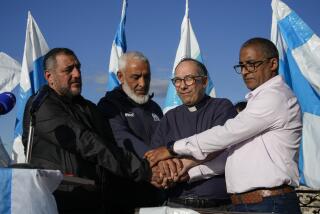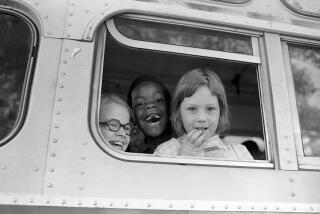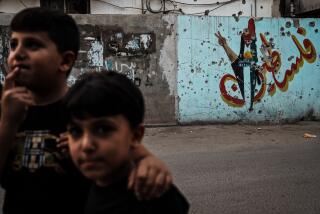Children Taught Ethnic Division in Bosnia-Herzegovina
- Share via
BILALOVAC, Bosnia-Herzegovina — The whitewashed stucco walls of the village school are still freckled with bullet holes -- scars of a war that ended more than a decade ago.
Inside the building, the war has left scars of a different kind.
Each day, Muslim and Croat children gather in the schoolyard. The two groups mingle comfortably. Boys kick a soccer ball. Girls gather in tight gaggles, whispering and casting shy glances toward the boys.
But when the bell sounds and the children scramble up the steps into the school, a kind of invisible curtain descends. They are no longer just kids; they become Muslims and Croats and they go their separate ways.
In Bosnia-Herzegovina, this is what is known as a “divided school.” It has separate classrooms for Muslims and Croats, separate teachers and administrations, separate textbooks and separate cleaning ladies.
“This is politics,” said Suljo Nuhic, principal of the school’s Muslim side. “We don’t like it, but nobody is asking us what we like.”
The Bilalovac school has about 100 Croat students and 280 Muslims -- or Bosniaks, as they prefer to call themselves these days.
Nuhic says he gets along fine with his Croat counterpart, whose office is next to his.
“Every day we have coffee together, and all of the teachers have normal, human, everyday cooperation,” he said.
But not all of Bosnia’s divided schools enjoy such amicable relations. In Zepce, 30 miles north of Bilalovac, Croats attend classes in the morning and Bosniaks go in the afternoon. The two groups never mix. Elsewhere in Bosnia-Herzegovina, separate entrances and “Berlin Walls” in corridors enforce the division.
“Divided schools are a symbol of what’s happening in this country,” said Erna Ribar, with the United Nations Children’s Fund in Sarajevo.
More than 10 years after the Dayton peace agreement ended the fighting, Bosnia remains a ward of the international community, ruled by a dysfunctional government and riven by ethnic rivalries. It is a country with a flag no one salutes and a national anthem no one sings.
The good news is that the economy is growing at a brisk 5% a year, and with the quiet presence of 7,000 European Union troops, there is little danger of a return to armed conflict. The downside: Unemployment is 39%, and the war’s two most wanted criminals, Radovan Karadzic and Gen. Ratko Mladic, remain at large.
Some analysts say the Dayton agreement has become part of the problem. The agreement ended the bloodshed by partitioning the country into a Bosnian Serb republic and a federation of Muslims and Croats. It also gave the country a weak central government and a constitution that emphasized ethnic or “national” prerogatives rather than individual rights.
Last year, there was a major U.S.-backed initiative to strengthen the central government and guide Bosnia-Herzegovina toward genuine multiethnic integration. It was supposed to be last November on the 10th anniversary of the Dayton agreement, but Bosnian politicians balked. It remains unratified.
One of the main casualties of the existing constitution is the education system.
“It’s ridiculous,” said Fatima Hodzic, 14, an eighth-grader at the Bilalovac school. “All the kids are coming to school together; we are having fun together -- and suddenly when we get here, we are separated.”
When it was drafted, the Dayton constitution’s emphasis on “national rights” was seen as a strategy that would help lure refugees back. It was thought that if refugees, especially those in the minority in a particular area, were assured that their children would be taught in their “national” language, they would feel better about returning.
To a degree, the strategy worked. The problem is that the national language of the old Yugoslavia was Serbo-Croat. When Serbs and Croats parted ways, so did the language, although the linguistic differences are considered superficial. Bosnian Muslims, who also spoke Serbo-Croat, now call their language Bosniak.
“Politicians use language as a weapon, and children are the victims,” said Radmila Rangelov-Jusovic of Step by Step, an international organization that trains teachers.
“The politicians manipulate parents to think that something bad will happen to their children if they are not taught in their national language. It’s destructive,” she said.
“School is how you begin to reconstruct communities. On a local level people understand this, but in Bosnia politics runs education at every level,” she said.
In addition to being taught in their respective national languages, each group has its own curriculum that emphasizes its separateness. For example, history textbooks for Serbs treat Gavrilo Princip, the Bosnian Serb whose assassination of Austrian Archduke Franz Ferdinand triggered World War I, as a hero; in the Croat texts, he is a terrorist.
Five years ago, Bosnian education authorities reached an interim agreement that was meant to recognize differences while unifying the basic content of the curriculum. It never was implemented, and the divisions have become deeper.
“When you start teaching them at age 6 that they are separate and that they can’t sit in the same classrooms, what’s going to happen when they are 26?” asked Melisa Nizic, an education specialist who has been working with Bosniak students and teachers at the Bilalovac school for about a year.
“When I first came here, I didn’t know how the system worked,” she recalled. “So I asked questions: Do I say hello to the other teachers? Are there fights in the halls? Can I talk to kids from the other group? I was told, ‘You can, but be careful with your words.’ ”
In school districts that are mono-ethnic, the problem may be worse.
“If you go to [heavily Croat] western Herzegovina, there are children who believe that Croatia is their country and [Croatian wartime leader Franjo] Tudjman is their greatest hero. They never even encounter someone from the other groups,” Step by Step’s Rangelov-Jusovic said.
Nearly everyone agrees that the present system is wasteful and inefficient. The scarce resources that could be used to rebuild infrastructure are squandered on producing three sets of textbooks and staffing schools with “ethnically correct” teaching staffs and administrations
At the Bilalovac school, Milenka Skopljaka, a Croat teacher, watches as her students pour out of the building at the end of the day and the curtain of ethnic indoctrination is momentarily lifted.
“You can see for yourself: The kids are playing together normally. It’s not their fault we have this system,” she said. “The fault is ours -- the adults, the parents and teachers.”
More to Read
Sign up for Essential California
The most important California stories and recommendations in your inbox every morning.
You may occasionally receive promotional content from the Los Angeles Times.










